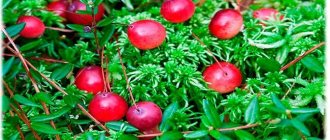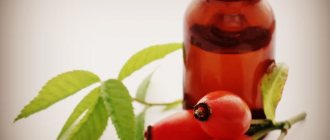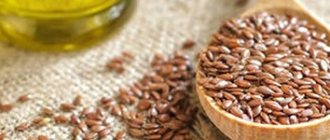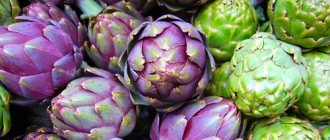Cranberries are one of the most nutritious berries that tolerate low temperatures well. It is no coincidence that it can usually be found in the northern regions.
The beneficial properties of this red gift from nature are known in many countries. It is valued for its ability to retain its energy composition even during long-term storage. Vitamins and minerals are not lost even if raw materials are processed into fruit drinks or made into jam. It is enough to adhere to the rules of minimal heat treatment, making a tasty mass with sugar that can be stored in the refrigerator for months.
According to Indian legend, the cranberry first appeared as a symbol of the lands where brave warriors fell. The Delawares (as this people were called) believed that it was there that the warriors died in a battle with mythical giants.
What kind of berry is this
Wild cranberries are a member of the Heather family and are common in northern latitudes. This is a close “relative” of lingonberries, blueberries, and blueberries. It is a small, green subshrub with spreading shoots. The berries growing in the swamp are quite small (up to 16 mm in diameter). In the places where they grow, everything is covered with a “red carpet”.
The shape of the fruit is round, in some varieties it resembles an ellipse. Colors change depending on ripeness. Unripe cranberries are pink with light sides and a dense consistency, while ripe ones are bright red and juicy.
Cranberries are late berries, ripening in September-October. It is believed that a fully ripe berry is one that has overwintered under the snow. By spring, the sharply sour taste changes to sweetish. Cranberries are 90% water; when picked, they burst easily in your hands, and only 10% are active components.
Thanks to organic acids, the fruit is well stored and helps preserve other products. The Indians rolled pieces of meat in its juice and stored them for a long time.
Where do cranberries grow?
The common cranberry is an inhabitant of ancient swamps, the age of which is estimated at millions of years. Her favorite places are peat, tundra and sphagnum bogs, which are located in damp coniferous forests and swampy lowlands. Cranberries in swamps grow only in ecologically clean places, where there is fresh water, forest air, and a lot of light. It bears fruit well in areas where humans rarely set foot.
The time when cranberries are harvested is in summer, autumn and spring. The “summer” berry is hard, not ripe, and contains a small amount of useful substances. “Autumn” acquires a purple color and juiciness: this is the time to collect healthy berries. But there are lovers of “spring” cranberries, which become sweeter, but practically cannot be stored.
Manual collection is very difficult and time-consuming. “Cranberry plantations” are found in different places. For the miracle berry you need to go in good equipment: viscous soil under your feet, mosquitoes, horseflies and picking each individual berry is not for the weak. There are hand-held collection containers, but environmentalists prohibit them. Such devices injure the bushes, which may not recover. So the supply of berries is gradually depleted.
Any schoolchild will answer the question where cranberries grow in Russia. Since we live in the middle and northern latitudes, sour berries are common in the northern regions: Siberia, the Urals, Kamchatka, Sakhalin, and the Far Eastern District.
A variety of wild large-fruited shrub common in Canada. The berry grows up to 25 mm in diameter. Based on wild plants, cultivated large-fruited varieties have been created that can be grown on your own plot.
Main characteristics
The plant belongs to the group of flowering evergreen shrubs of the heather family. Dried or dried cranberries are a product dried using a special technology. The taste of dried cranberries is pleasant and sweet, the berries are red in color, have a spherical shape, do not stick together and have a pleasant and rich aroma.
Content:
- Main characteristics
- Chemical composition and nutritional value
- Beneficial features
- Contraindications and harm
- Culinary use
- Cooking at home
- Application in cosmetology and dietetics
The plant loves a temperate climate, is widespread throughout Russia, and is often found in marshy areas. The size of such berries can reach 16 mm. Berries are collected in the fall - from early September to late November.
Composition and nutritional value
Despite the significant water content in the composition, there are more than enough nutrients in the berry. The chemical composition of cranberries is a unique combination of vitamins and minerals that help people maintain immunity, restore strength and energy. The benefits of the fruit are enormous; they contain:
- “Vitamin cocktail” from group B, K, A, PP, C. What vitamins are contained in the greatest quantities in cranberries? Of course, this is ascorbic acid.
- Mineral complex consisting of macro- and microelements.
- A large set of organic acids: citric, malic, ursolic, chlorogenic, benzoic and others. They are what give cranberries their rich, sour taste.
- A small amount of sugars: glucose and fructose.
- A set of antioxidants.
- Pectins and fiber (dietary fiber). The pectin content is quite high.
The healing properties of ripe cranberries are associated with this unique composition. As for the presence of carbohydrates, fats, proteins BJU, their content is extremely insignificant:
- proteins – 0.5 g;
- fats – 0.2 g;
- carbohydrates – 3.7 g per 100 g of product.
Carbohydrates predominate, but they do not add much calorie content to the product.
Harvesting method
For medicinal purposes, ripe berries are used, collected in the fall before the plants are covered with snow. Cranberries collected in early spring after the snow has melted are more tasty, they accumulate a lot of citric acid, but they are almost devoid of vitamins and do not last long. The berries collected at the end of August and September are quite hard, but ripen and become softer during storage. In October, the berries become dark and juicy. Cranberries collected in late autumn can be stored until the next harvest (mainly due to the presence of benzoic acid, which can kill microbes and suppress putrefactive processes). Berries caught by frost should be stored frozen.
Beneficial properties for the human body
Many people living in the northern regions are well aware of the benefits of cranberries and why they help. It is usually frozen and used for preparing dishes or drinks at any time of the year. The miracle berry perfectly retains all its beneficial properties:
- Lowers temperature and relieves inflammation. Effectively affects viruses, but in complex therapy. Can enhance the effects of antibiotics.
- Strengthens the body's immune protective barrier. It helps well as a prophylactic during the period of “rampant” infections, reducing the likelihood of colds.
- Reduces the content of “bad cholesterol”, preventing the formation of cholesterol plaques and brings a person’s blood pressure back to normal for age. Helps in solving problems with vascular and heart diseases.
- Strengthens the nervous system and increases mental activity due to the content of potassium and B vitamins in the juice.
- Improves the activity of the gastrointestinal tract, eliminating signs of heartburn, increasing appetite and intestinal motility due to the presence of dietary fiber and pectin.
- Helps with disorders of the genitourinary system, but is not the main, but an additional remedy for drug therapy.
- Participates in preventive dental treatment: relieves gum inflammation, inhibits the development of caries. Previously, cranberries helped get rid of scurvy, which developed with a lack of ascorbic acid (teeth became loose and fell out).
- Stops the growth of cancer cells, reducing the risk of malignant tumors thanks to the antioxidants in the composition.
The benefits of cranberries for the body are not limited to the listed properties. There are folk methods for treating various diseases, where the northern berry is present in teas, decoctions, and potions.
Not only the fruits, but also the leaves bring benefits. Decoctions from the leaves have antibacterial properties. They wash wounds and use them for sore throats. Tea with leaves, taken in a bath, helps the body get rid of toxins.
Useful properties for women
The fair sex should also not neglect the “gifts of the north.” Cranberry brings the following benefits to a woman’s body:
- improves the condition of hair, relieving its owner of split ends, strengthens the nail plate;
- helps get rid of extra pounds, since the chemical composition of berries is involved in the breakdown of fats;
- is a preventive remedy for genitourinary problems: women often suffer from cystitis and develop urolithiasis.
Cranberry juice is an essential dessert offered in some restaurants after a fatty meal. The drink destroys fats and relieves stomach discomfort.
Beneficial properties during pregnancy
The benefits during pregnancy are obvious: cranberry juices or drinks can replace multivitamin complexes. They can be added to fresh berry juices to get a full set of vitamins. Northern berry helps during pregnancy:
- fill the body of the mother and the unborn baby with useful components;
- boost immunity and reduce the risk of various infections;
- in the first trimesters, reduce toxicosis due to an sour drink;
- in the last trimesters, relieve swelling and pressure surges.
The expectant mother does not need to eat fresh berries. It is much healthier to consume fruit drinks, compotes, and jelly. If desired, you can add sugar or honey to drinks to reduce the sour taste. The berry is prohibited if a pregnant woman suffers from allergies or gastrointestinal diseases: ulcers, gastritis, enterocolitis.
What are the benefits for men
The benefits of cranberries for men reduce the risk of prostatitis or prostate disease. Thanks to the enzymatic composition of the fruit, the risk of infections of the bladder and genitourinary system as a whole is reduced. There is a way to treat male impotence: a single daily intake of 300 ml of fresh juice. This will help solve the problem in combination with other treatment methods.
Benefits for children
Mothers know how cranberries are beneficial for children. Children have poorly developed immunity, so this is the best remedy in the fight against infectious agents (viruses, bacteria, fungi). Taking syrups or fruit drinks with northern berries during a cold increases sweating and reduces fever, gradually removing signs of inflammation. It is a strong antiseptic that can fight microbial colonies. Its antitussive effect is also known. The beneficial properties of cranberries are aimed at:
- fight against dysbacteriosis;
- removal of poisonous and toxic compounds;
- treatment of skin problems such as dermatitis, eczema;
- preventing problems with teeth and gums.
They try to introduce the juice of one or two berries into the diet from 6 months, after diluting it with water. From one to three years of age, children are allowed drinks as a vitamin and preventative against colds, but only in diluted form.
Cranberries should not be considered an ordinary delicacy. Diluted juice is a potent drink that is recommended for children in the amount of one glass per day.
Medicinal properties of cranberries
Traditional medicine has long adopted this valuable taiga fruit. But it is important to know for which diseases cranberry really becomes a reliable assistant and brings benefits. What does the “northern healer” treat and what recipes can you safely use for emerging diseases? Cranberry is used:
- To cleanse the intestines, removing stagnant feces and toxic compounds in their composition. The recipe is simple: you need to mix cranberry and beet juice in equal proportions and drink 3-5 sips 3 times a day. The same remedy is recommended for cramps and constipation.
- For colds, to relieve inflammation, prepare a mixture of equal parts of aloe juice, cranberry, lemon, honey and vodka. Sugar is added as desired. The mixture is stored in a cool place and taken three times a day, 2 tbsp. l.
- To restore physical strength, use cranberry juice, half diluted with water. The drink is useful for people involved in sports or physical labor. It will give you vigor due to the multivitamin complex in its composition.
- For hypertension, a mixture of cranberries (500 g) and sugar (150 g), diluted with 250 ml of water, helps. The mixture is boiled for 10 minutes, cooled and diluted half with water. It is enough to take a glass of the product per day.
- For diabetes, it will help normalize the amount of sugar in the blood. To do this, grind a handful of cranberries, pour in 250 ml of hot water and let the drink infuse for an hour. Take twice a day in a volume of 50 ml.
- As a preventive measure for problems of the genitourinary system, diluted cranberry juice (1:3) 100 ml daily is useful.
- For diarrhea, a folk remedy has been created based on berries and leaves in equal parts. The mixture is boiled for 5 minutes, pouring 500 ml of hot water. Take 4 times a day, 130 ml.
Cranberry treatment is useful as a disease prevention or it is used as an additional, supportive agent during drug therapy when the disease is already developing.
How does freshly squeezed juice, fruit drink, syrup, jam, cranberry leaves affect the body?
Cranberry beneficial properties vary depending on the method of application. Freshly squeezed juice contains few tannins and pectins, but the antimicrobial effect does not change during long-term storage, autoclaving, or boiling. When making jam and syrup, the amount of vitamins is reduced. They are destroyed when cooked.
Cranberries in the forest on a branch
Research has been conducted on how cranberry juice affects the body. Canadian scientists conducted tests (description and results published in the journal Food chemistry for 2012, No. 132, pp. 959 – 967), and found that cranberry juice:
- strengthens the immune system;
- prevents relapses of inflammation of the genitourinary system;
- reduces blood pressure;
- effective for the treatment and prevention of colon cancer.
The proanthocyanidins it contains prevent the formation of tartar.
Daily intake of 400 ml of juice:
- reduces the concentration of low-density lipoproteins and cholesterol in the blood;
- prevents atherosclerotic changes in the vascular wall;
- reduce the risk of cardiovascular pathologies.
Cranberry juice
Cranberry juice is prescribed for the treatment of colds. It reduces temperature and regulates water-salt balance. There is one drawback (apart from contraindications) - many useful substances remain in the processing waste.
Identified in cranberry squeeze:
- bioflavonoids;
- phenolic acids;
- microelements.
But this drawback is compensated by the fact that the juice can be stored longer (boiled and rolled into jars, autoclaved).
Instead of juice they drink fruit drink. Due to the special cooking technology, beneficial substances from the skin and seeds (during their boiling) pass into liquid. If you heat them to 700C, the vitamins are preserved.
Syrup is the same boiled juice, but with added sugar. It has a sweet taste and is thick. It is used not for treatment, but for making delicious desserts, although it is also useful.
Homemade cranberry jam
Jam is made to keep the berries longer. With the correct preparation technology, maximum beneficial properties are preserved. Cranberry jam:
- antipyretic;
- anti-inflammatory;
- anti-carcinogenic;
- antimicrobial.
Due to the sugar it contains, it is contraindicated for diabetics.
The leaves contain almost the same substances as the fruits. They make anti-cold tea. They are infused with alcohol. Take 2 - 3 teaspoons per day to prevent ARVI, joint diseases, and general health promotion. Young leaves are used.
Dried frozen cranberries which is healthier
Due to the high content of organic acids, cranberries are perfectly stored. Just put it in jars and add a little sweetened water. This is the so-called pickled cranberry, which does not spoil for a long time.
Freezing also perfectly preserves all the taste and beneficial qualities of red fruits. The benefits and harms of frozen cranberries are exactly the same as fresh ones. Northern berries are dried in modern dryers or ovens, slightly wilting or completely removing moisture from the berries.
Which product is healthier: fresh or dried? After any treatment carried out correctly, the berry retains its healing properties. The only downside is the dried product, as it becomes quite high in calories. But first place in the ranking should be given to frozen fruits, which perfectly preserve the appearance and internal potential of a vitamin-rich product.
During drying, the oven doors should be slightly open to allow excess moisture to evaporate, and the temperature should be +40C. The dried product springs back when pressed and does not crumble into dust.
Cranberry juice
Cranberry juice provides great opportunities for culinary imagination: you can use it to prepare jellies, mousses, syrups, fresh juices, herbal teas, and berry infusions. But cranberry juice remains beyond competition. As our grandmothers claimed and contemporaries agree with them, “there is nothing healthier in the world than fruit juice.”
Morse is a cold drink that contains:
- 600 g cranberries;
- 1 cup of sugar;
- 2.5 liters of water.
The ingredients are mixed and taken in the summer as a light, vitamin drink, and in the winter to prevent colds.
Harm of cranberries
Cranberries have contraindications because the product contains many organic acids with a sharp, sour taste. If a person is healthy and does not overuse berries, then the benefits will be fully manifested. But with some symptoms, treatment with cranberries will be not only harmful, but also dangerous to health:
- for gastritis and liver diseases, manifested in acute form;
- with the development of peptic ulcer of any part of the gastrointestinal tract and at any stage;
- with weak tooth enamel, which will be actively destroyed by acids;
- in case of allergic manifestations or individual intolerance.
If a person has many chronic diseases, then it is better to consult with your doctor or drink diluted juice in moderation.
The northern berry is well absorbed by the body; it grew in our open spaces and has been consumed by Russian people for many years. This is not an overseas fruit that can cause confusion or indigestion. Cranberries, which inhabit centuries-old swamps, give them power, strength and help them survive in the difficult conditions of the Russian climate.
Description
Perennial evergreen, small subshrub from 15 to 30 cm in height with thin adventitious roots. Thin, thread-like creeping reddish-brown stems spread along the ground and take root at the nodes. On short, erect, flowering shoots there are simple small, leathery, short-petiolate, ovoid leaves with edges turned down and a network of veins protruding on the underside (shiny, dark green above, and ash-white below). During the flowering period, pinkish or purple regular drooping flowers appear on long, slightly pubescent peduncles (one per peduncle and four in the leaf axil). The calyx is four-toothed, the corolla is four-parted with bent lobes, there are eight stamens, one pistil, the ovary is inferior, four-locular, multi-seeded. Cranberry fruits are dark red, spherical or ovoid berries with a diameter of up to 16 mm.











